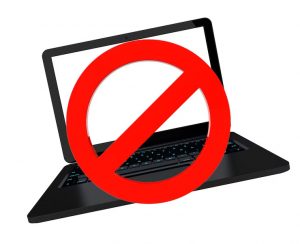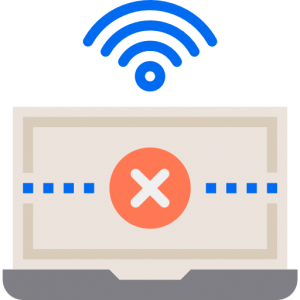Computer Not Connected To Internet
In today’s digitally interconnected world, a computer keeps dropping internet connection can feel like an abrupt disruption to our daily lives. Whether for work, communication, research, or entertainment, a reliable internet connection is crucial. However, when you find yourself facing the frustrating dilemma of a computer not connected to internet, it’s essential to understand that solutions are within reach. In this comprehensive blog, we’ll unravel the mysteries behind this computer slow internet issue and guide you through the steps to diagnose and resolve it. Join us on a trip to restore your computer’s internet connectivity and recover access to the enormous online world, whether you’re a tech enthusiast or a casual user.
Why Computer Keeps Dropping Internet Connection?
When your computer keeps dropping internet connection, it can be a frustrating and disruptive experience. This problem can hinder your productivity, interrupt online activities, and leave you searching for answers. In this blog, we’ll delve into the various factors that can contribute to a computer not connected to internet. Understanding these probable reasons can assist you in determining the source of the problem and seeking appropriate solutions.
- Wireless Interference: One common reason for computer keeps dropping internet connection is wireless interference. Electronic devices, neighboring networks, and even physical barriers can disrupt Wi-Fi signals.
- Router Overload: Routers can become overwhelmed when handling too many connected devices or heavy network traffic. This overload can lead to computer says no internet.
- Outdated or Incompatible Drivers: Drivers that control your computer’s network hardware may become outdated or incompatible with your current operating system, resulting in computer slow internet issues.
- Faulty Network Hardware: Hardware problems, such as a malfunctioning network card or a damaged Ethernet cable, can lead to intermittent internet disconnections, causing computer connected but no internet.
- Network Congestion: Congested networks, especially during peak usage times, can cause internet connection drops. Overloaded servers and network infrastructure may struggle to accommodate high traffic.
- Software Conflicts: Incompatible software, such as firewalls or security applications, can interfere with your computer’s ability to maintain a stable internet connection, leading to computer connected but no internet.
 IP Address Conflicts: IP address conflicts within your network can disrupt connectivity. Devices with conflicting IP addresses may cause network instability or computer not connected to internet.
IP Address Conflicts: IP address conflicts within your network can disrupt connectivity. Devices with conflicting IP addresses may cause network instability or computer not connected to internet.- DNS Issues: Problems with Domain Name System (DNS) settings can hinder your computer’s ability to resolve web addresses into IP addresses, leading to computer slow internet problems.
- Router Firmware Problems: Outdated or buggy router firmware can result in computer keeps dropping internet connection. Router manufacturers often release firmware updates to address such issues.
- ISP or Service Provider Problems: Your internet service provider (ISP) may experience network outages or technical problems that affect your connection. These issues are typically beyond your control.
- Environmental Factors: Environmental variables such as harsh weather or electrical interference might have an impact on the quality of your internet connection.
- Network Congestion: High traffic on your network, especially if many devices are streaming or downloading data simultaneously, can lead to computer slow internet issues.
Experiencing computer not connected to internet issue can be an exasperating and disruptive ordeal. It’s essential to recognize that there can be a myriad of contributing factors to this issue, ranging from physical hardware problems to software conflicts and external network conditions.
How to Fix Computer Slow Internet Issue:
Experiencing computer keeps dropping internet connection can be a frustrating and perplexing problem. However, with the right troubleshooting steps, you can often identify and resolve the issue. In this guide, we’ll walk you through how to fix computer not connected to internet issue:
- Check Physical Connections: If your computer says no internet, start with the basics. Ensure all cables, including Ethernet cables or Wi-Fi adapters, are securely plugged in. If you’re using Wi-Fi, verify that your wireless router or access point is powered on and functioning correctly.
- Restart Your Computer: A simple restart can often clear temporary glitches and resolve computer slow internet issues. Restart your computer to see whether your internet connection has been restored.
- Restart Your Router or Modem: If you’re using a wireless router or a modem, unplug it from the power source, wait for about 30 seconds, and then plug it back in. Allow the device to fully restart. This can refresh your connection with the Internet Service Provider (ISP).
- Check Other Devices: If other devices on the same network can connect to the internet, it’s likely an issue with your computer. However, if all devices are experiencing connectivity problems, the issue might be with your network or ISP.
- Disable and Re-enable Wi-Fi (Wireless Connections): If you’re using Wi-Fi, disable and then re-enable your Wi-Fi adapter. You can do this through your computer’s network settings or by toggling the Wi-Fi switch on your laptop.
- Check for Airplane Mode: If your computer keeps dropping internet connection, ensure that your computer is not in Airplane Mode, as this can disable all network connections.
- Troubleshoot Network Problems: Both Windows and macOS offer built-in network troubleshooters. Use these tools to automatically diagnose and fix common connectivity issues.

- Review Network Settings: If your computer says no internet, check your network settings to confirm that your computer is set to automatically receive an IP address and DNS server address (DHCP). Incorrect settings can prevent internet access.
- Update Network Drivers: Outdated or corrupted network drivers can lead to computer slow internet problems. Download and install the latest network adapter drivers from the manufacturer’s website.
- Disable and Re-enable Network Adapter (Ethernet): If you’re using a wired Ethernet connection, try disabling and re-enabling the network adapter in your computer’s network settings.
- Run a Malware and Virus Scan: Malware or viruses can sometimes interfere with network connectivity. Run a thorough scan using reputable antivirus software to ensure your computer is clean.
- Check Firewall and Security Software: Your firewall or security software settings might be blocking internet access. Review and adjust your security settings as needed.
- Reset TCP/IP Stack: In some cases, resetting the TCP/IP stack can resolve network issues. As an administrator, launch a command prompt and type ‘netsh int ip reset resetlog.txt.’ After that, restart your computer.
- Check for Proxy Settings: If your computer keeps dropping internet connection, ensure that your computer’s proxy settings are correctly configured. Incorrect proxy settings can prevent internet access.
- Contact Your ISP: If none of the preceding procedures resolve the problem, contact your Internet Service Provider (ISP) to determine whether there are any network outages or account-related issues.
By systematically following these troubleshooting steps, you can often pinpoint the cause of your computer’s internet connectivity issue and take the appropriate actions to resolve it. Remember that specific solutions may vary depending on your computer’s operating system and hardware, so consult your device’s manual or seek assistance from a professional technician if needed.
Conclusion:
Computer not connected to internet issue can be a vexing problem, but it can often be solved with patience and systematic troubleshooting. We’ve explored a range of potential solutions, from checking physical connections and restarting devices to reviewing network settings, updating drivers, and running diagnostics.
Remember, the exact steps and solutions may vary based on your computer’s operating system and network setup. However, armed with the knowledge and guidance provided in this blog, you are well-equipped to tackle the issue and restore your computer’s internet connectivity. To know more about our support services, you can navigate to our website’s Homepage.
